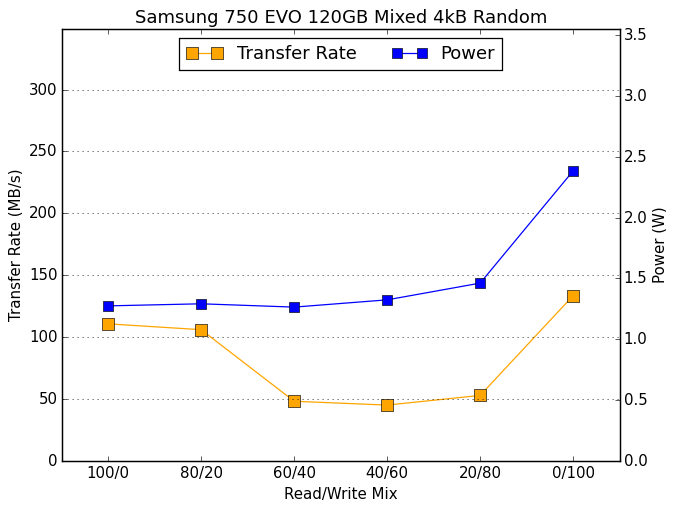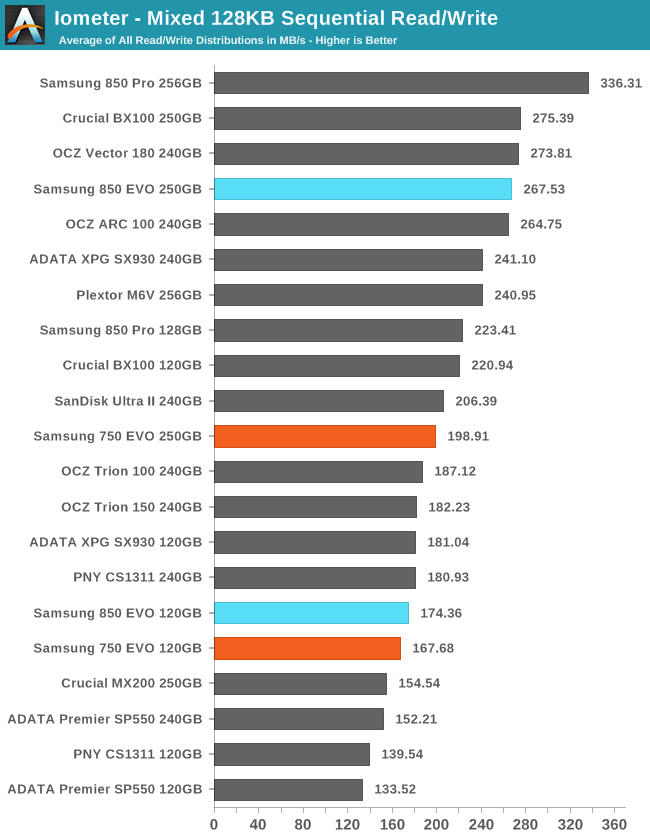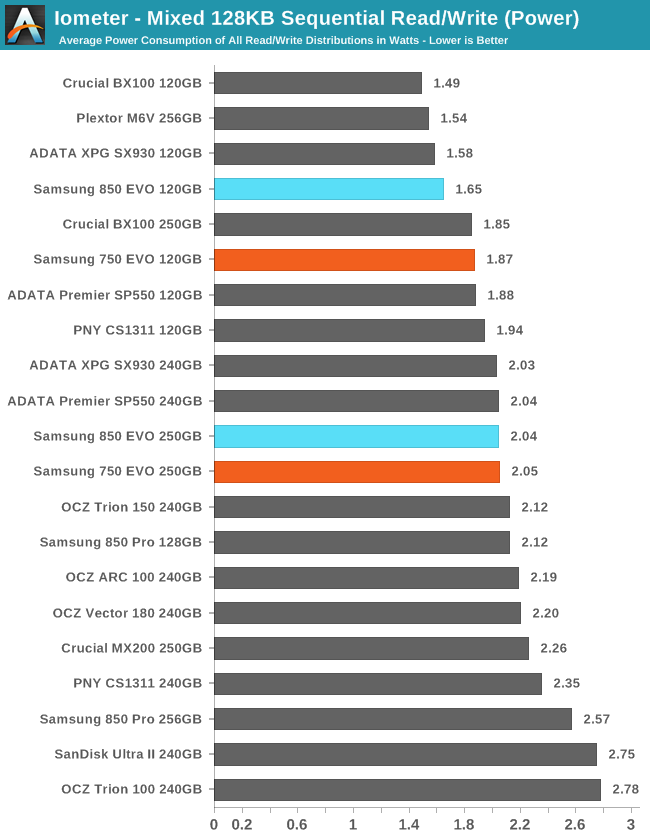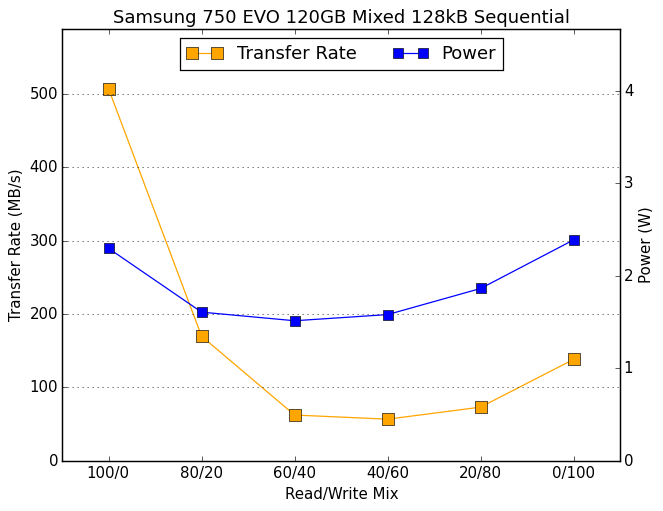The Samsung 750 EVO (120GB & 250GB) SSD Review: A Return To Planar NAND
by Billy Tallis on April 22, 2016 8:00 AM ESTMixed Random Read/Write Performance
The mixed random I/O benchmark starts with a pure read test and gradually increases the proportion of writes, finishing with pure writes. The queue depth is 3 for the entire test and each subtest lasts for 3 minutes, for a total test duration of 18 minutes. As with the pure random write test, this test is restricted to a 16GB span of the drive, which is empty save for the 16GB test file.

The 750 EVO outperforms any non-Samsung drive of similar capacity on the mixed random I/O test, and the 120GB 750 EVO even beats a few MLC drives with twice the capacity.

The 750 EVO has above-average power efficiency during the mixed random I/O test.
 |
|||||||||
Most drives lose performance during the middle phases of the mixed random I/O test. High performance scores on this test rely on performance bouncing back during the final phase of the test when the workload shifts to pure writes. The 750 EVO's spike at the end is noticeable though not huge, but it also benefits from comparatively good performance in the first two sub-tests.
Mixed Sequential Read/Write Performance
The mixed sequential access test covers the entire span of the drive and uses a queue depth of one. It starts with a pure read test and gradually increases the proportion of writes, finishing with pure writes. Each subtest lasts for 3 minutes, for a total test duration of 18 minutes. The drive is filled before the test starts.

Unlike for the mixed random I/O test, most MLC drives are able to maintain a clear performance lead over the planar TLC drives—including the 750 EVO.

The 750 EVO's power consumption is low enough that it is clearly the most efficient planar TLC drive, but its efficiency doesn't beat a typical MLC drive.
 |
|||||||||
The 750 EVO has great read speed, but it bottoms out at a relatively low level during the middle of the test and doesn't bounce back at the end as much as most MLC drives and the 850 EVO.










109 Comments
View All Comments
lilmoe - Friday, April 22, 2016 - link
Meh. I'll wait until it's half price.haukionkannel - Friday, April 22, 2016 - link
Well, this is 10$ cheaper that 850evo, so this will be very popular among system builders and other with tight budget. Normal upgrade user will definitely go for 850. But this is good enought to most customers.Space Jam - Friday, April 22, 2016 - link
$10 for considerably worse performance does not a winner make.I have a hard time swallowing the cheapo, terrible performance $60 TLC drives. If Sammy thinks anything more than $65 is a good price they have another thing coming.
$60 for a budget 120GB SSD is some audacity.
I and most others will stick to BX100s @ $70 and 850 EVOs @ $75 during the (frequent) sales.
jabber - Friday, April 22, 2016 - link
And if it's upgrading a lot of the older machines desktops and laptops that still only run on SATA II...it doesn't matter. As long as it pushes 285MBps (ish) all day that's all it needs. A lot of kit out there is still SATA II.Alexvrb - Friday, April 22, 2016 - link
Yeah it's got a sequential speed cap. Not all tasks are about peak speeds. I'm pretty sure in terms of IOPS a decent SSD will still beat the snot out of an OEM-grade penny-pinching budget model, even on old SATA 2. Which brings us back to the idea that this is for OEMs and builders - truly this is a "builder-grade" component. If you're upgrading or building for yourself, you'll likely pay a few extra bucks for an 850 Evo or similar unit.With that being said, any of the modern SSDs are better than a mechanical drive. Blech.
leexgx - Wednesday, April 27, 2016 - link
this drive will likely be perfect for the older apple laptops that have that dodgy cable that does not support SATA 3 but the controller does (the cable fails if a high speed cable is used) i had to use a DVD HDD caddy on number of apple laptops due to that issue where it will not detect the SSD or HDDleexgx - Wednesday, April 27, 2016 - link
high speed drive is used (not cable is used) edit be nice on here but that's unlikelyDeath666Angel - Friday, April 22, 2016 - link
I'm guessing the marketing value for "Performance Samsung SSD inside" is considerably higher than comparable Sandisk or Crucial SSDs. And the 10 bucks off compared to the 850 means the margins remain. And if current 1TB laptop drives get replaced by these 250GB 750s, I think everyone is a winner. :DSamus - Monday, April 25, 2016 - link
It's funny you mention that because I would prefer a Sandisk or Crucial/Micron drive over a Samsung anyday.Have you ever tried warranting a Samsung drive? They are hell to deal with. And yes, I still have a sour metallic taste after the 840 Evo debacle that essentially was never fixed.
I also think Crucial/Sandisks Marvell drives, albeit slower, are more consistent, stable and deal with power loss substantially better than the MGX. The fact Samsung is making an SSD with 35TBW endurance in 2016 is pretty damning. I've seen 20GB racked up on old Intel X25-M's in a matter of years so 35GB in a 5 year period isn't out of the question. Just about any other SSD or hard disk for that matter will handle double that no problem at the rated capacity.
vladx - Monday, April 25, 2016 - link
" after the 840 Evo debacle that essentially was never fixed."Don't know what you mean, I also have a 840 EVO and can confirm the performances issues are gone after the 2nd fix.